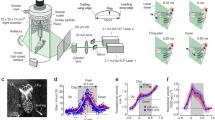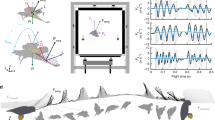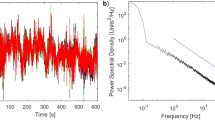Abstract
Flying insects generate forces that are too large to be accounted for by conventional steady-state aerodynamics1,2. To investigate these mechanisms of force generation, we trained red admiral butterflies, Vanessa atalanta, to fly freely to and from artificial flowers in a wind tunnel, and used high-resolution, smoke-wire flow visualizations to obtain qualitative, high-speed digital images of the air flow around their wings. The images show that free-flying butterflies use a variety of unconventional aerodynamic mechanisms to generate force: wake capture3, two different types of leading-edge vortex3,4,5,6,7, active and inactive upstrokes8, in addition to the use of rotational mechanisms3 and the Weis–Fogh ‘clap-and-fling’ mechanism9,10,11,12. Free-flying butterflies often used different aerodynamic mechanisms in successive strokes. There seems to be no one ‘key’ to insect flight, instead insects rely on a wide array of aerodynamic mechanisms to take off, manoeuvre, maintain steady flight, and for landing.
This is a preview of subscription content, access via your institution
Access options
Subscribe to this journal
Receive 51 print issues and online access
$199.00 per year
only $3.90 per issue
Buy this article
- Purchase on Springer Link
- Instant access to full article PDF
Prices may be subject to local taxes which are calculated during checkout




Similar content being viewed by others
References
Sane, S. P. & Dickinson, M. H. The aerodynamic effects of wing rotation and a revised quasi-steady model of flapping flight. J. Exp. Biol. 205, 1087–1096 (2002)
Zbikowski, R. On aerodynamic modelling of an insect-like flapping wing in hover for micro air vehicles. Phil. Trans. R. Soc. Lond. A 360, 273–290 (2002)
Dickinson, M. H., Lehmann, F.-O. & Sane, S. P. Wing rotation and the aerodynamic basis of insect flight. Science 284, 1954–1960 (1999)
Maxworthy, T. The fluid-dynamics of insect flight. Ann. Rev. Fluid Mech. 13, 329–350 (1981)
Ellington, C. P., van den Berg, C., Willmott, A. P. & Thomas, A. L. R. Leading-edge vortices in insect flight. Nature 384, 626–630 (1996)
Van den Berg, C. & Ellington, C. P. The vortex wake of a hovering model hawkmoth. Phil. Trans. R. Soc. Lond B 352, 317–328 (1997)
Birch, J. M. & Dickinson, M. H. Spanwise flow and the attachment of the leading-edge vortex on insect wings. Nature 412, 729–733 (2001)
Saffman, P. G. & Sheffield, J. S. Flow over a wing with an attached free vortex. Studies Appl. Math. 57, 107–117 (1977)
Weis-Fogh, T. Quick estimates of flight fitness in hovering animals, including novel mechanisms for lift production. J. Exp. Biol. 59, 169–230 (1973)
Lighthill, J. On the Weis-Fogh mechanism of lift generation. J. Fluid Mech. 60, 1–17 (1973)
Maxworthy, T. Experiments on the Weis-Fogh mechanism of lift generation by insects in hovering flight. Part 1. Dynamics of the ‘fling’. J. Fluid Mech. 93, 47–63 (1979)
Ellington, C. P. Biological Fluid Dynamics Symp. Soc. Exp. Biol. (eds Ellington, C. P. & Pedley, T. J.) Vol. 49, 109–129 (Company of Biologists, Cambridge, 1995)
Rossow, V. J. Lift enhancement by an externally trapped vortex. J. Aircraft 15, 618–625 (1978)
Rossow, V. J. Two-fence concept for efficient trapping of vortices on airfoils. J. Aircraft 29, 847–855 (1992)
Rossow, V. J. Aerodynamics of airfoils with vortex trapped by two spanwise fences. J. Aircraft 31, 146–153 (1994)
Huang, M.-K. & Chow, C.-Y. Trapping of a free vortex by Joukowski airfoils. Am. Inst. Aeronaut. Astronaut. J. 20, 292–298 (1982)
Mourtos, N. J. & Brooks, M. Flow past a flat plate with a vortex/sink combination. J. Appl. Mech. 63, 543–550 (1996)
Riddle, T. W., Wadcock, A. J., Tso, J. & Cummings, R. M. An experimental analysis of vortex trapping techniques. J. Fluids Eng. 121, 555–559 (1999)
Gursul, I. & Ho, C.-M. High aerodynamic loads on an airfoil submerged in an unsteady stream. Am. Inst. Aeronaut. Astronaut. J. 30, 1117–1119 (1992)
Gad-el-Hak, M. & Ho, C.-M. Unsteady vortical lift around three-dimensional lifting surfaces. Am. Inst. Aeronaut. Astronaut. J. 24, 713–721 (1986)
Délery, J. M., Legendre, R. & Werlé, H. Toward the elucidation of three-dimensional separation. Ann. Rev. Fluid Mech. 33, 129–154 (2001)
Perry, A. E. & Chong, M. S. A description of eddying motions and flow patterns using critical-point concepts. Ann. Rev. Fluid Mech. 19, 125–155 (1987)
Tobak, M. & Peake, D. J. Topology of three-dimensional separated flows. Ann. Rev. Fluid Mech. 14, 61–85 (1982)
Lighthill, M. J. Laminar Boundary Layer Theory Section II 2.6 (ed. Rosenhead, L.) 72–82 (Oxford Univ. Press, New York, 1963)
Legendre, R. Separation de L'ecoulement laminaire tridimensionnel. Rech. Aeronaut. 54, 3–8 (1956)
Poincaré, H. Les points singulièrs des équations différentielles. C.R. Acad. Sci. Paris 94, 416–418 (1882)
Hornung, H. & Perry, A. E. Some aspects of three-dimensional separation. I: Streamsurface bifurcations. Z. Flugwiss. Weltraumforsch. 8, 77–87 (1984)
Willmott, A. P., Ellington, C. P. & Thomas, A. L. R. Flow visualisation and unsteady aerodynamics in the flight of the hawkmoth Manduca sexta. Phil. Trans. R. Soc. Lond. B 352, 303–316 (1997)
Rayner, J. M. V., Jones, G. & Thomas, A. L. R. Vortex flow visualizations reveal change in upstroke function with flight speed in bats. Nature 321, 162–164 (1986)
Spedding, G. R. Advances in Comparative Environmental Physiology 11. Mechanics of Animal Locomotion (ed. Alexander, R. M.) (Springer, Berlin, 1993)
Acknowledgements
We thank the Engineering and Physical Sciences Research Council instrument pool for use of their NAC500 high-speed video camera. R.B.S. was supported by a Biotechnology and Biological Sciences Research Council grant to A.L.R.T. A.L.R.T. was supported by a Royal Society University Research Fellowship.
Author information
Authors and Affiliations
Corresponding author
Ethics declarations
Competing interests
The authors declare that they have no competing financial interests.
Rights and permissions
About this article
Cite this article
Srygley, R., Thomas, A. Unconventional lift-generating mechanisms in free-flying butterflies. Nature 420, 660–664 (2002). https://doi.org/10.1038/nature01223
Received:
Accepted:
Issue Date:
DOI: https://doi.org/10.1038/nature01223
This article is cited by
-
Evolution, types, and distribution of flight control devices on wings and elytra in bark beetles
Scientific Reports (2024)
-
Investigate the Wake Flow on Houseflies with Particle-Tracking-Velocimetry and Schlieren Photography
Journal of Bionic Engineering (2023)
-
Physical models and vortex dynamics of swimming and flying: a review
Acta Mechanica (2022)
-
Design and analysis of an untethered micro flapping robot which can glide on the water
Science China Technological Sciences (2022)
-
Vortex trapping recaptures energy in flying fruit flies
Scientific Reports (2021)
Comments
By submitting a comment you agree to abide by our Terms and Community Guidelines. If you find something abusive or that does not comply with our terms or guidelines please flag it as inappropriate.



